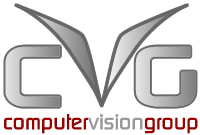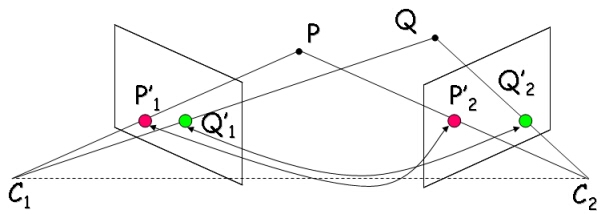


| Home | People | Research | Projects | Teaching | Theses | Downloads | Links | Contacts |  |
 |

|
 |
|||||||||||||

|
||||||||||||||
|
||||||||||||||
 |
Projects
|
|
|
Image-based measurements in machine vision: technology hintsImage metrologyThree-dimensional image metrology have become a well-accepted technology for industrial quality control. Fundamentally, it is based on two techniques: photogrammetry and videogrammetry.Photogrammetry is a measurement technology in which the 3D geometric properties of an object are derived from two or more 2D still images, taken under different positions. It uses the basic principle of triangulation, whereby the intersecting lines of sight in space and the camera orientation (i.e. camera position joint to shot angle) are used to compute the 3D location of all points. Videogrammetry is a measurement technology in which the spatial 3D coordinates of object points are recovered by combining measurements made in two or more video images taken under different shot angles. Images can be obtained from two or more cameras which simultaneously view the object or from successive images captured by one camera moving around the object. Differently from photogrammetry, this requires the capability to detect and analyse the motion of the object and/or of the camera (ego-motion). 3D stereoscopyFusing the images recorded by our two eyes and exploiting the difference (or disparity) between them allows us to achieve a 3D perception. Stereo vision is a technique exploiting a couple of cameras (C1,C2 in Fig. 1), placed at a known distance (baseline), to derive depth information by triangulation, using each point of the real object (e.g. P and Q) and their projection on the two image sensors (e.g. P'1,P'2 and Q'1,Q'2 in Fig. 1), according to photogrammetry principles.
Fig. 1: The depth information of the object points P and Q can be recovered using triangulation, where the baseline C1C2 is known and the point couples 1 and 2 in the first and second image lay on the same (epipolar) line, after image rectification. The main problem is determining which pixels on the left correspond to which pixels on the right. Through geometrical analysis it can be proved that the matching points lie on the same (epipolar) line, after each image has been rectified. After that, the camera geometric information (intrinsics) permits to compute position and 3D structure of the object.Stereo matching is used in many applications, like 3D-reconstruction, autonomous vehicles and 3D measurements. An interesting application can be found in automotive, where the accurate spatial position of the vehicle’s longitudinal axis is required before characterizing the headlamp beams for testing purposes. Usually, these systems are made of ensembles of sensors or are invasive, needing fiducial markers placed on the vehicle being tested. Two classes of algorithms are known to search for correspondent points. Correlation-based algorithms produce a dense set of correspondences, while feature-based algorithms produce a sparse set. |
Copyright © 2008, A.G. - All Rights Reserved
|